An Agent-Based Model for Zip-Code Level Diffusion of Electric Vehicles and Electricity Consumption in New York City
Abstract
1. Introduction
2. Innovation Diffusion Theories
- : the rate of market growth by the new technology at a given time t;
- : the half of fractional growth in early years of diffusion; and
- : the time taken to reach a 50% of market share.
3. Agent-Based Modeling and Its Applications in EV Diffusion
4. Methodology
4.1. Data Gathering
4.2. Utility Function Formulation
- Uit: the utility value for zip code i at iteration t;
- ; and,
- Xit: the number of EVs for zip code i in each weight elements in each iteration.
4.3. Agent-Based Approach
5. Results
6. Conclusions and Future Work
Author Contributions
Conflicts of Interest
References
- Daziano, R.A.; Chiew, E. Electric vehicles rising from the dead: Data needs for forecasting consumer response toward sustainable energy sources in personal transportation. Energy Policy 2012, 51, 876–894. [Google Scholar] [CrossRef]
- Nezamoddini, N.; Wang, Y. Risk management and participation planning of electric vehicles in smart grids for demand response. Energy 2016, 116, 836–850. [Google Scholar] [CrossRef]
- Rezvani, Z.; Jansson, J.; Bodin, J. Advances in consumer electric vehicle adoption research: A review and research agenda. Transp. Res. Part D Transp. Environ. 2015, 34, 122–136. [Google Scholar] [CrossRef]
- Lutsey, N. Global Milestone: The First Million Electric Vehicles. 2015. Available online: http://www.theicct.org/blogs/staff/global-milestone-first-million-electric-vehicles (accessed on 31 July 2017).
- Fazli Khalaf, A.; Wang, Y. Economic and environmental evaluations of dedicated and residential electric tariffs for plug-in electric vehicles. Int. J. Energy Res. 2018, 42, 542–558. [Google Scholar] [CrossRef]
- Brouwer, A.S.; Kuramochi, T.; van den Broek, M.; Faaij, A. Fulfilling the electricity demand of electric vehicles in the long term future: An evaluation of centralized and decentralized power supply systems. Appl. Energy 2013, 107, 33–51. [Google Scholar] [CrossRef]
- Clement-Nyns, K.; Haesen, E.; Driesen, J. The impact of vehicle-to-grid on the distribution grid. Electr. Power Syst. Res. 2011, 81, 185–192. [Google Scholar] [CrossRef]
- Mu, Y.; Wu, J.; Jenkins, N.; Jia, H.; Wang, C. A spatial–temporal model for grid impact analysis of plug-in electric vehicles. Appl. Energy 2014, 114, 456–465. [Google Scholar] [CrossRef]
- Römer, B.; Reichhart, P.; Kranz, J.; Picot, A. The role of smart metering and decentralized electricity storage for smart grids: The importance of positive externalities. Energy Policy 2012, 50, 486–495. [Google Scholar] [CrossRef]
- Arellano, B.; Sena, S.; Abdollahy, S.; Lavrova, O.; Stratton, S.; Hawkins, J. Analysis of electric vehicle impacts in New Mexico urban utility distribution infrastructure. In Proceedings of the Transportation Electrification Conference and Expo (ITEC), Detroit, MI, USA, 16–19 June 2013. [Google Scholar]
- Paevere, P.; Higgins, A.; Ren, Z.; Horn, M.; Grozev, G.; McNamara, C. Spatio-temporal modelling of electric vehicle charging demand and impacts on peak household electrical load. Sustain. Sci. 2014, 9, 61–76. [Google Scholar] [CrossRef]
- Yang, Z.; Li, K.; Foley, A. Computational scheduling methods for integrating plug-in electric vehicles with power systems: A review. Renew. Sustain. Energy Rev. 2015, 51, 396–416. [Google Scholar] [CrossRef]
- Schaal, E. The State of Electric Vehicle Charging. 2016. Available online: https://www.fleetcarma.com/electric-vehicle-charging-2016-maps/ (accessed on 27 June 2017).
- U.S. Department of Energy. Electric Vehicle Charging Station Locations. 2017. Available online: http://www.afdc.energy.gov/fuels/electricity_locations.html (accessed on 27 July 2017).
- Bullis, K. Could Electric Cars Threaten the Grid? MIT Technology Review. 2013. Available online: https://www.technologyreview.com/s/518066/could-electric-cars-threaten-the-grid/ (accessed on 28 June 2017).
- Rogers, E.M. Diffusion of Innovations; Free Press: New York, NY, USA, 2003. [Google Scholar]
- Fisher, J.C.; Pry, R.H. A simple substitution model of technological change. Technol. Forecast. Soc. Chang. 1971, 3, 75–88. [Google Scholar] [CrossRef]
- Bass, F.M. A new product growth for model consumer durables. Manag. Sci. 1969, 15, 215–227. [Google Scholar] [CrossRef]
- Hannisdahl, O.H.; Malvik, H.V.; Wensaas, G.B. The future is electric! The EV revolution in Norway—Explanations and lessons learned. In Proceedings of the IEEE 2013 World Electric Vehicle Symposium and Exhibition (EVS27), Barcelona, Spain, 17–20 November 2013; pp. 1–13. [Google Scholar]
- Schelly, C. Residential solar electricity adoption: What motivates, and what matters? A case study of early adopters. Energy Res. Soc. Sci. 2014, 2, 183–191. [Google Scholar] [CrossRef]
- Adepetu, A.; Keshav, S.; Arya, V. An agent-based electric vehicle ecosystem model: San Francisco case study. Transp. Policy 2016, 46, 109–122. [Google Scholar] [CrossRef]
- Bertotti, M.L.; Brunner, J.; Modanese, G. The Bass diffusion model on networks with correlations and inhomogeneous advertising. Chaos Solitons Fractals 2016, 90, 55–63. [Google Scholar] [CrossRef]
- Eppstein, M.J.; Grover, D.K.; Marshall, J.S.; Rizzo, D.M. An agent-based model to study market penetration of plug-in hybrid electric vehicles. Energy Policy 2011, 39, 3789–3802. [Google Scholar] [CrossRef]
- Lai, M.; Poltera, Y. Lecture with Computer Exercises: Modelling and Simulating Social Systems with Matlab; Technical Report; Swiss Federal Institute of Technology: Zurich, Switzerland, 2009; p. 27. [Google Scholar]
- McCoy, D.; Lyons, S. Consumer preferences and the influence of networks in electric vehicle diffusion: An agent-based micro simulation in Ireland. Energy Res. Soc. Sci. 2014, 3, 89–101. [Google Scholar] [CrossRef]
- Shin, J.K.; Sayama, H. Theoretical investigation on the Schelling’s critical neighborhood demand. Commun. Nonlinear Sci. Numer. Simul. 2014, 19, 1417–1423. [Google Scholar] [CrossRef][Green Version]
- Silvia, C.; Krause, R.M. Assessing the impact of policy interventions on the adoption of plug-in electric vehicles: An agent-based model. Energy Policy 2016, 96, 105–118. [Google Scholar] [CrossRef]
- Wolf, I.; Schröder, T.; Neumann, J.; de Haan, G. Changing minds about electric cars: An empirically grounded agent-based modeling approach. Technol. Forecast. Soc. Chang. 2015, 94, 269–285. [Google Scholar] [CrossRef]
- Pasqualetti, M.J.; Brown, M.A. Ancient discipline, modern concern: Geographers in the field of energy and society. Energy Res. Soc. Sci. 2014, 1, 122–133. [Google Scholar] [CrossRef]
- Eising, J.W.; van Onna, T.; Alkemade, F. Towards smart grids: Identifying the risks that arise from the integration of energy and transport supply chains. Appl. Energy 2014, 123, 448–455. [Google Scholar] [CrossRef]
- Hagerstrand, T. Innovation Diffusion as a Spatial Process; University of Chicago Press: Chicago, IL, USA, 1967. [Google Scholar]
- Saarenpää, J.; Kolehmainen, M.; Niska, H. Geodemographic analysis and estimation of early plug-in hybrid electric vehicle adoption. Appl. Energy 2013, 107, 456–464. [Google Scholar] [CrossRef]
- Macal, C.M.; North, M.J. Tutorial on agent-based modelling and simulation. J. Simul. 2010, 4, 151–162. [Google Scholar] [CrossRef]
- Daina, N.; Sivakumar, A.; Polak, J.W. Modelling electric vehicles use: A survey on the methods. Renew. Sustain. Energy Rev. 2017, 68, 447–460. [Google Scholar] [CrossRef]
- Shafiei, E.; Thorkelsson, H.; Ásgeirsson, E.I.; Davidsdottir, B.; Raberto, M.; Stefansson, H. An agent-based modeling approach to predict the evolution of market share of electric vehicles: A case study from Iceland. Technol. Forecast. Soc. Chang. 2012, 79, 1638–1653. [Google Scholar] [CrossRef]
- Cui, X.; Liu, C.; Kim, H.K.; Kao, S.C.; Tuttle, M.A.; Bhaduri, B.L. A multi agent-based framework for simulating household PHEV distribution and electric distribution network impact. TRB Commit. Transp. Energy 2010, 1250, 21. [Google Scholar]
- Bale, C.S.; McCullen, N.J.; Foxon, T.J.; Rucklidge, A.M.; Gale, W.F. Harnessing social networks for promoting adoption of energy technologies in the domestic sector. Energy Policy 2013, 63, 833–844. [Google Scholar] [CrossRef]
- Sweda, T.; Klabjan, D. An agent-based decision support system for electric vehicle charging infrastructure deployment. Paper Presented at Vehicle Power and Propulsion Conference (VPPC), Chicago, IL, USA, 6–9 September 2011. [Google Scholar]
- Linder, S.; Wirges, J. Spatial Diffusion of Electric Vehicles in the German Metropolitan Region of Stuttgart; ERSA Conference Papers, No. ersa11p557; European Regional Science Association: Barcelona, Spain, 2011. [Google Scholar]
- Noori, M.; Tatari, O. Development of an agent-based model for regional market penetration projections of electric vehicles in the United States. Energy 2016, 96, 215–230. [Google Scholar] [CrossRef]
- Al-Alawi, B.M.; Bradley, T.H. Review of hybrid, plug-in hybrid, and electric vehicle market modeling studies. Renew. Sustain. Energy Rev. 2013, 21, 190–203. [Google Scholar] [CrossRef]
- New York State Energy Research & Development Authority (NYSERDA). 2012. Available online: https://www.nyserda.ny.gov/ (accessed on 11 October 2017).
- The Official Website of New York State. Welcome to the State of New York. 2017. Available online: https://www1.nyc.gov/assets/doh/downloads/pdf/data/appb.pdf (accessed on 18 July 2017).
- United States Zip Codes. U.S. ZIP Codes: Free ZIP Code Map and Zip Code Lookup. 2017. Available online: http://www.unitedstateszipcodes.org (accessed on 21 July 2017).
- Clark, S. Zonal States Overlapping Polys Tool. 2012. Available online: http://www.arcgis.com/home/item.html?id=b859b33c616a47d2b99b5e133942db02 (accessed on 12 June 2017).
- Massiani, J.; Gohs, A. The choice of Bass model coefficients to forecast diffusion for innovative products: An empirical investigation for new automotive technologies. Res. Transp. Econ. 2015, 50, 17–28. [Google Scholar] [CrossRef]
- Delre, S.A.; Jager, W.; Bijmolt, T.H.; Janssen, M.A. Will it spread or not? The effects of social influences and network topology on innovation diffusion. J. Prod. Innov. Manag. 2010, 27, 267–282. [Google Scholar] [CrossRef]
- Mesarić, P.; Krajcar, S. Home demand side management integrated with electric vehicles and renewable energy sources. Energy Build. 2015, 108, 1–9. [Google Scholar] [CrossRef]
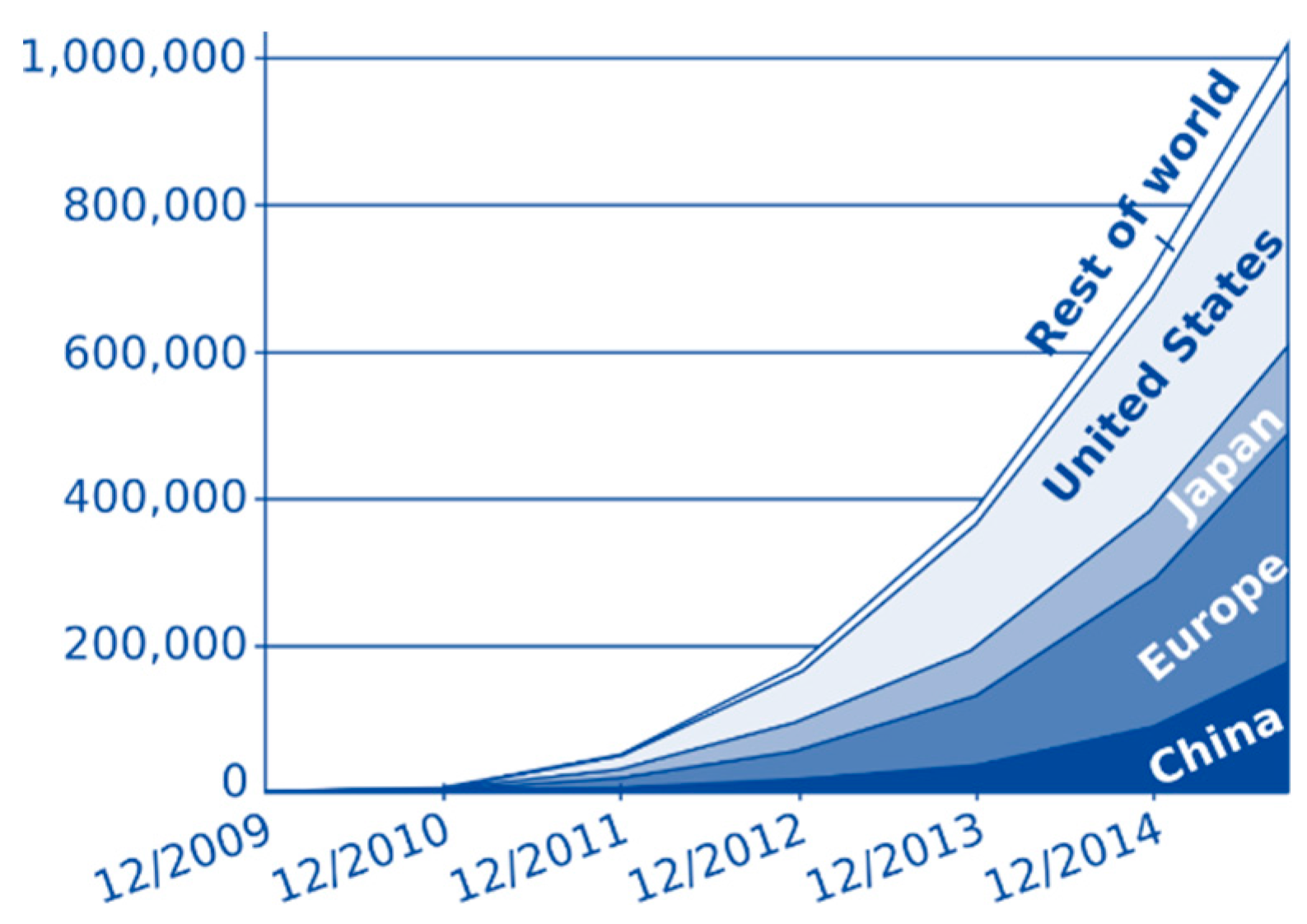


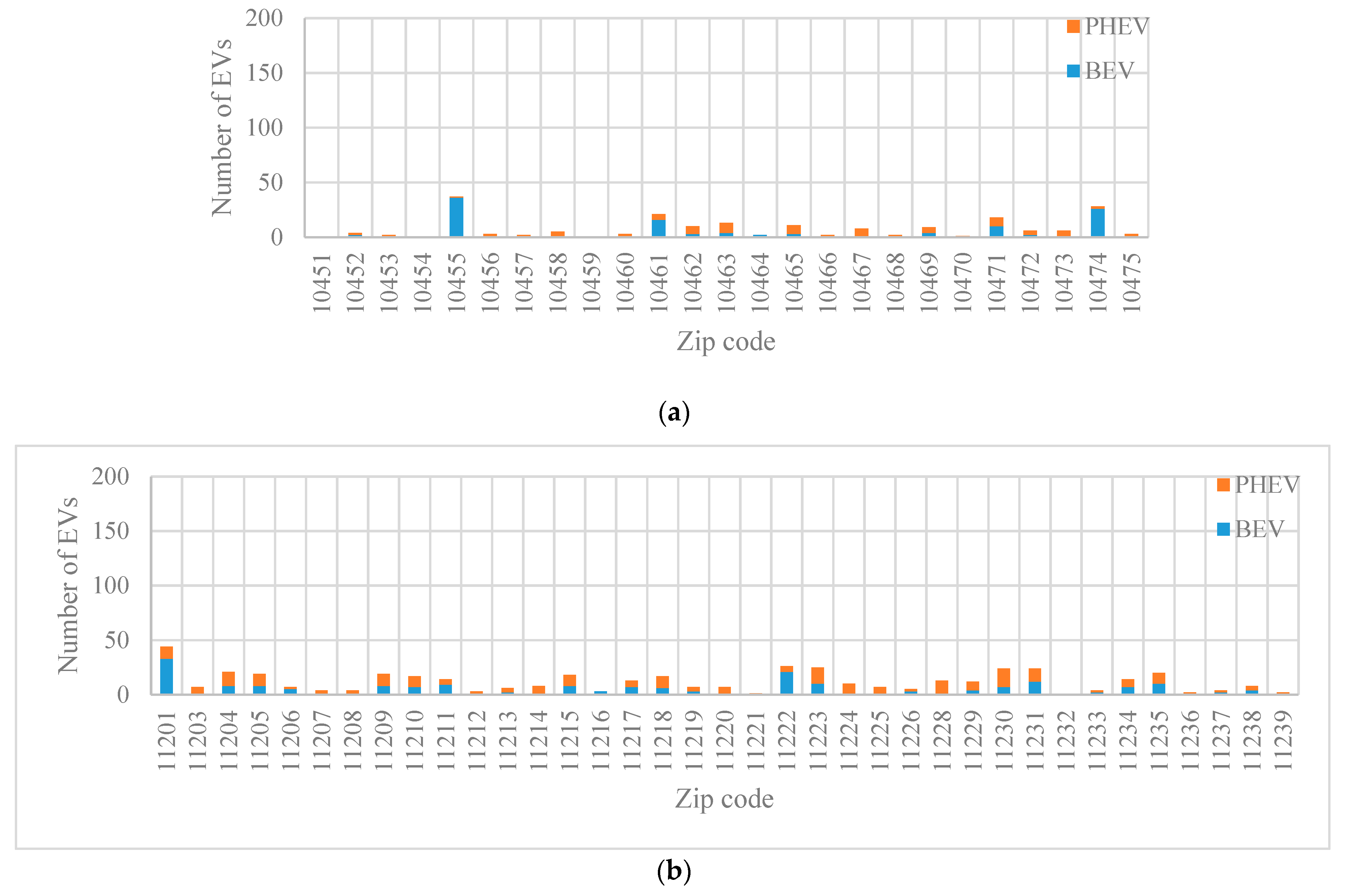
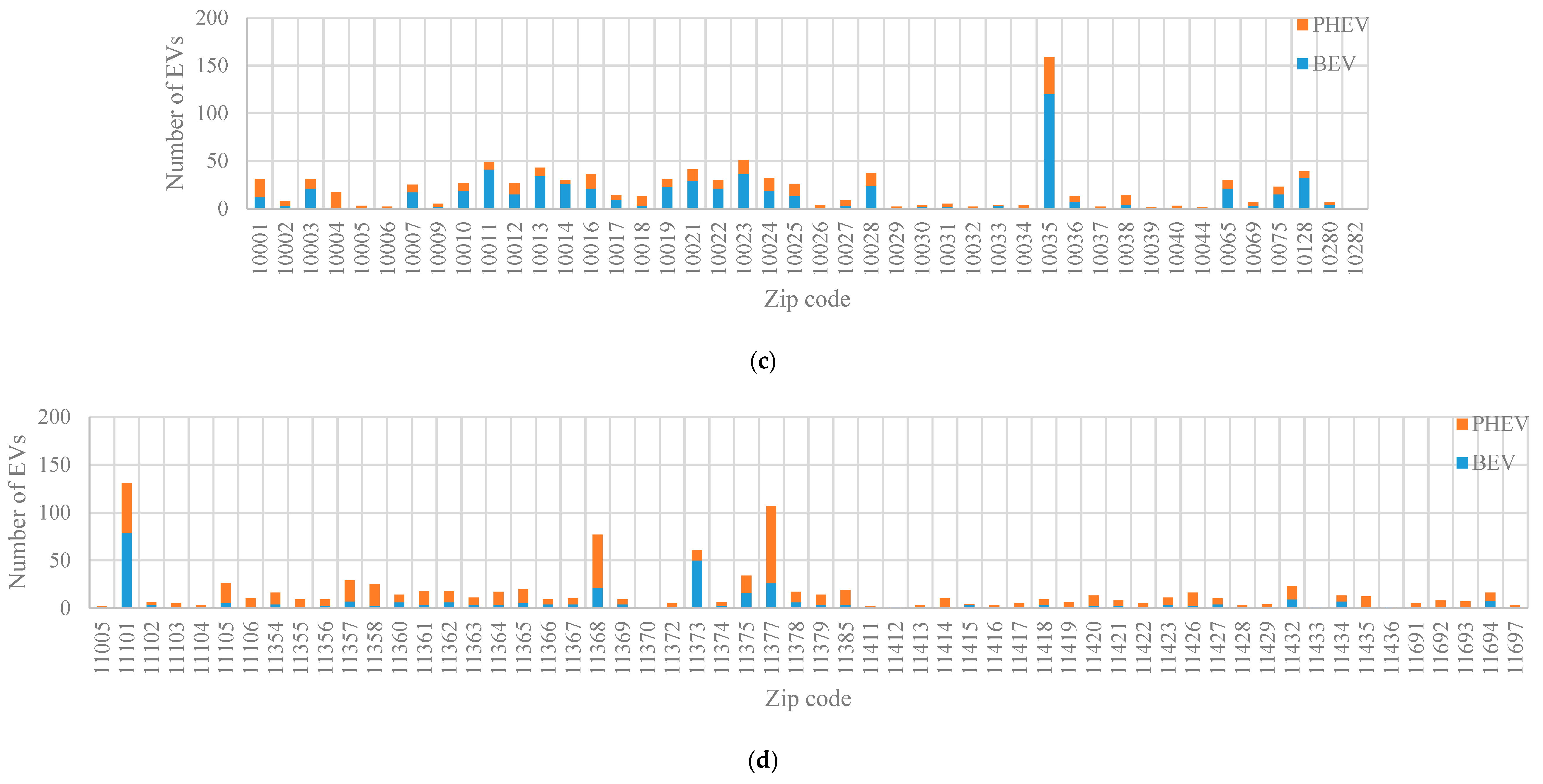
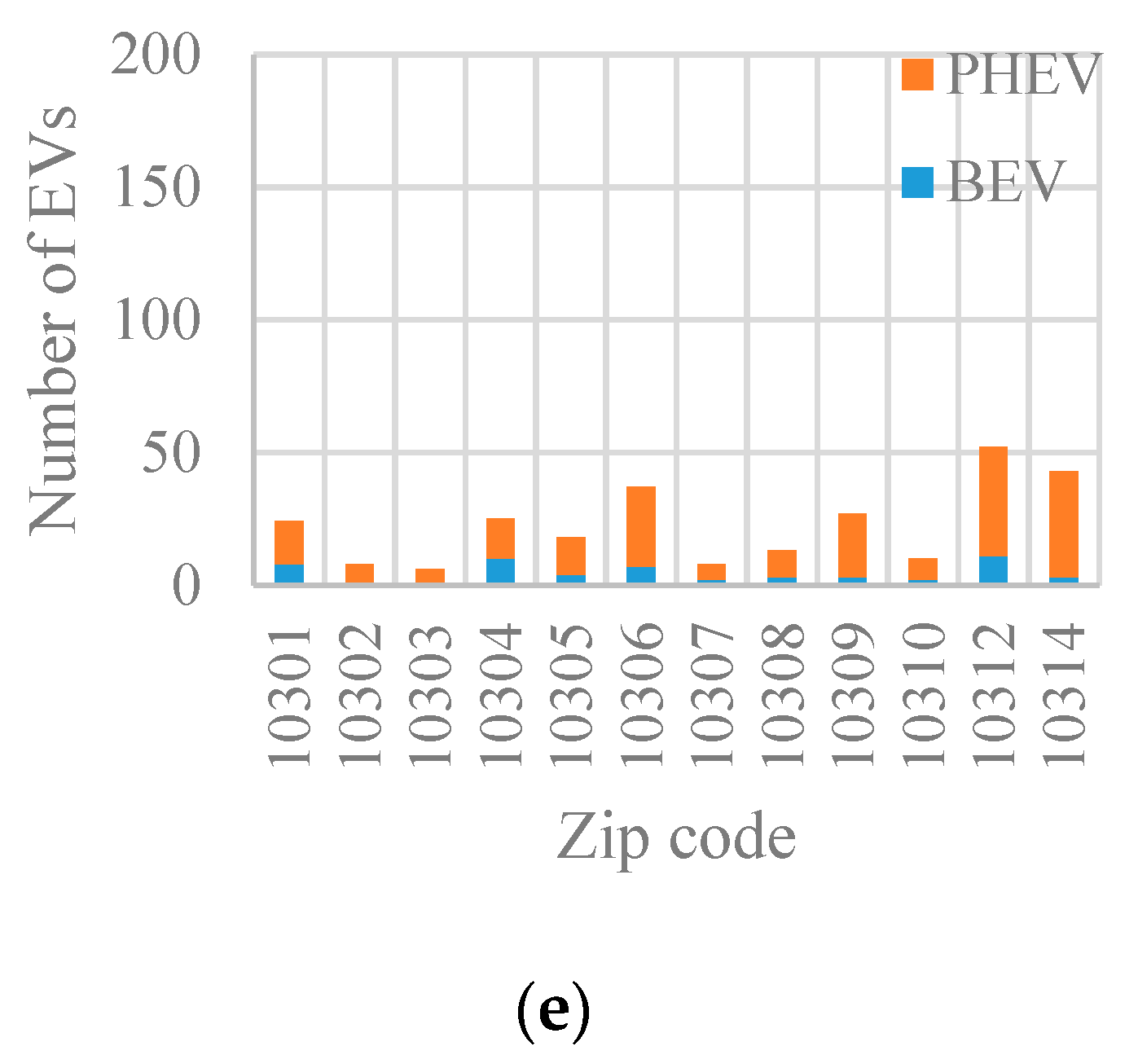

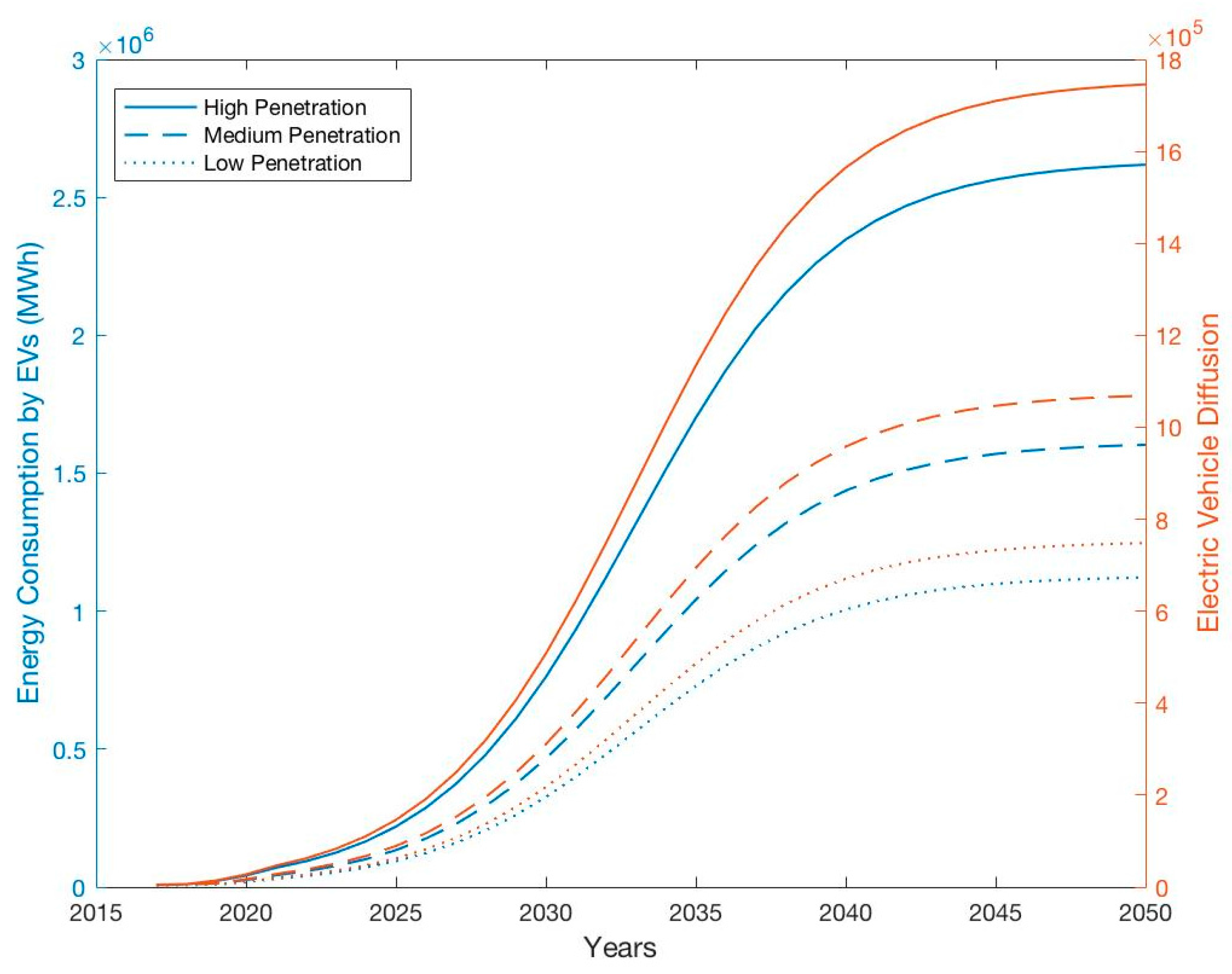

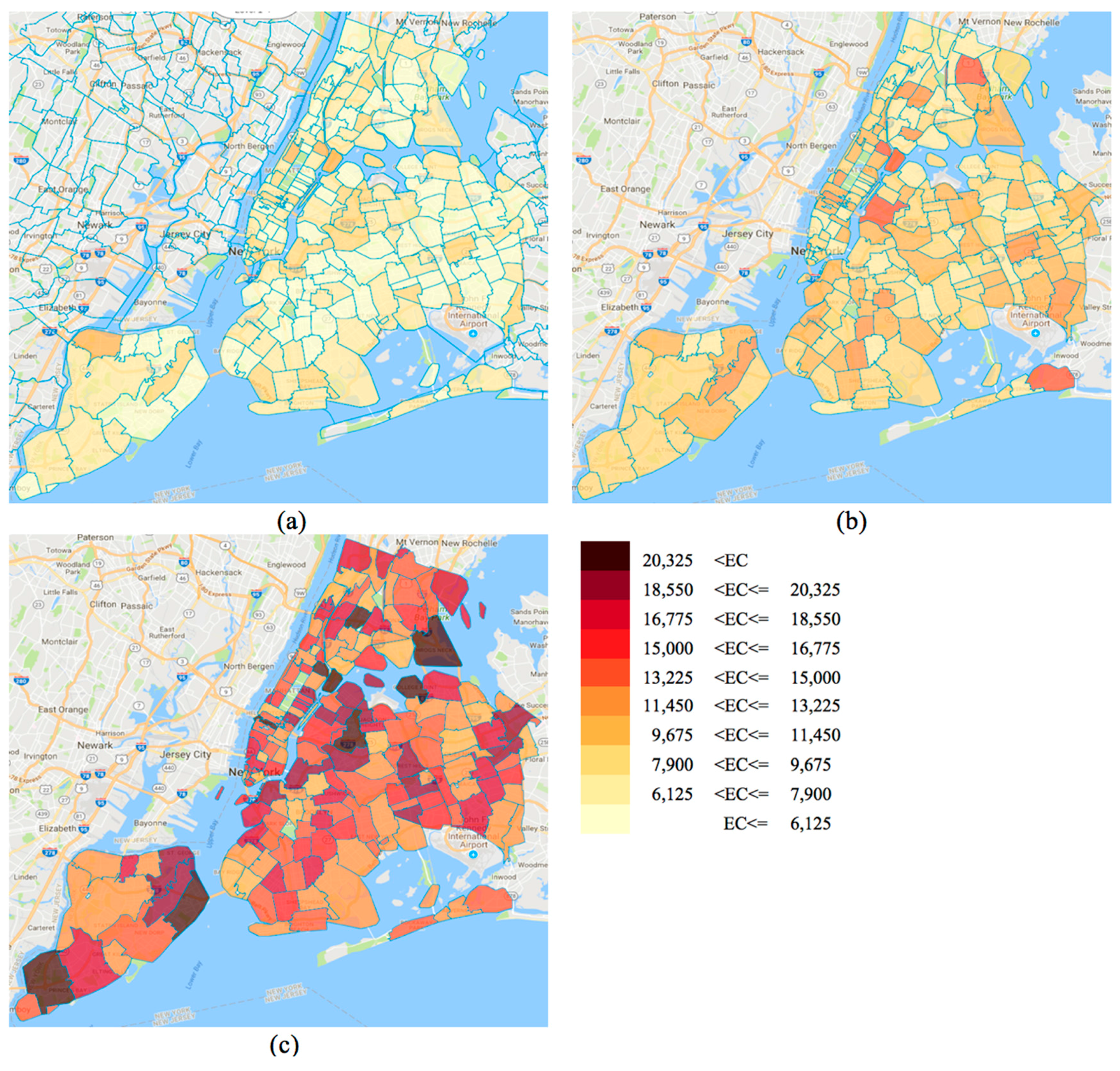
| Parameter | Estimate | Std. Error | t Value | Pr(>|t|) |
|---|---|---|---|---|
| (Intercept) | 9.44 | 15.9 | 0.594 | 0.553534 |
| pop | −97,400 | 0.00546 | −0.178 | 0.858661 |
| popd | −11,500 | 0.0000817 | −1.403 | 0.16267 |
| hu | 0.00301 | 0.00277 | 1.084 | 0.280251 |
| mhv | 0.0000255 | 0.0000147 | 1.738 | 0.008437 |
| la | 7.86 | 2.16 | 3.648 | 0.000367 |
| wa | −0.284 | 23.5 | −1.207 | 0.229384 |
| ohu | −237 | 0.0177 | −1.34 | 0.182395 |
| mhi | −10,800 | 0.0000841 | −1.281 | 0.202055 |
| ma | −17.9 | 0.344 | −0.52 | 0.604067 |
| gen | 0.00456 | 0.00291 | 1.571 | 0.118294 |
| rw | −1960 | 0.00481 | −0.408 | 0.684106 |
| rb | −1210 | 0.00487 | −0.247 | 0.804964 |
| ra | −7000 | 0.0299 | −0.234 | 0.815324 |
| ras | −1270 | 0.00486 | −0.262 | 0.793924 |
| rnh | −14.8 | 0.11 | −1.351 | 0.178874 |
| roth | 0.000123 | 0.00497 | 0.025 | 0.980256 |
| fam | 0.00314 | 0.00496 | 0.634 | 0.526823 |
| sing | −78,500 | 0.00354 | −0.222 | 0.824763 |
| nkid | 0.00234 | 0.00383 | 0.611 | 0.541949 |
| own | 0.0225 | 0.0166 | 1.355 | 0.177377 |
| rent | 0.0207 | 0.0165 | 1.253 | 0.212281 |
| wpop | −14,400 | 0.000871 | −0.166 | 0.86873 |
| unpop | −40,800 | 0.00115 | −0.354 | 0.723624 |
| ctv | −2610 | 0.00144 | −1.807 | 0.01287 |
| pubt | 0.000349 | 0.000966 | 0.362 | 0.718217 |
| le | −2000 | 0.00187 | −1.065 | 0.288733 |
| he | −0.001743 | 0.00256 | −0.681 | 0.496768 |
| Observation | 175 | |||
| R-Square | 0.7553 | |||
| Adj R-Sq | 0.6523 |
| Adopter Category (% of Total) | Adoption Threshold Score | α |
|---|---|---|
| Innovator (2.5%) | 0.1 | |
| Early-adopter (13.5%) | 0.15 | |
| Early-majority (34%) | 0.175 | |
| Late-majority (34%) | 0.225 | |
| Laggards (16%) | 0.25 |
| Annual EC (MWh) | Low | Medium | High | |||||||||
|---|---|---|---|---|---|---|---|---|---|---|---|---|
| 2035 Zip Code | 2050 Zip Code | 2035 Zip Code | 2050 Zip Code | 2035 Zip Code | 2050 Zip Code | |||||||
| # | % | # | % | # | % | # | % | # | % | # | % | |
| 175 | 100 | 172 | 98 | 175 | 100 | 113 | 64 | 165 | 94 | |||
| 3 | 2 | 62 | 36 | 10 | 6 | 98 | 57 | |||||
| 69 | 39 | |||||||||||
| 8 | 4 | |||||||||||
| Total | 175 | 100 | 175 | 100 | 175 | 100 | 175 | 100 | 175 | 100 | 175 | 100 |
© 2018 by the authors. Licensee MDPI, Basel, Switzerland. This article is an open access article distributed under the terms and conditions of the Creative Commons Attribution (CC BY) license (http://creativecommons.org/licenses/by/4.0/).
Share and Cite
Ahkamiraad, A.; Wang, Y. An Agent-Based Model for Zip-Code Level Diffusion of Electric Vehicles and Electricity Consumption in New York City. Energies 2018, 11, 640. https://doi.org/10.3390/en11030640
Ahkamiraad A, Wang Y. An Agent-Based Model for Zip-Code Level Diffusion of Electric Vehicles and Electricity Consumption in New York City. Energies. 2018; 11(3):640. https://doi.org/10.3390/en11030640
Chicago/Turabian StyleAhkamiraad, Azadeh, and Yong Wang. 2018. "An Agent-Based Model for Zip-Code Level Diffusion of Electric Vehicles and Electricity Consumption in New York City" Energies 11, no. 3: 640. https://doi.org/10.3390/en11030640
APA StyleAhkamiraad, A., & Wang, Y. (2018). An Agent-Based Model for Zip-Code Level Diffusion of Electric Vehicles and Electricity Consumption in New York City. Energies, 11(3), 640. https://doi.org/10.3390/en11030640




